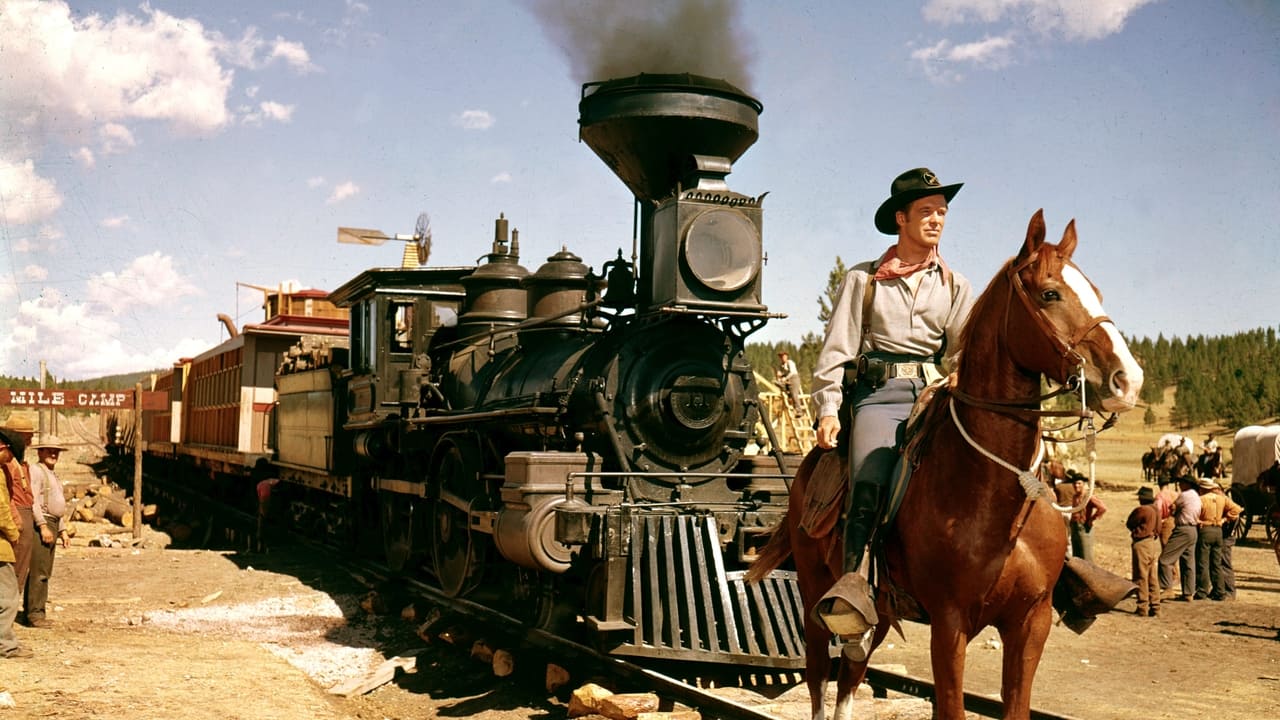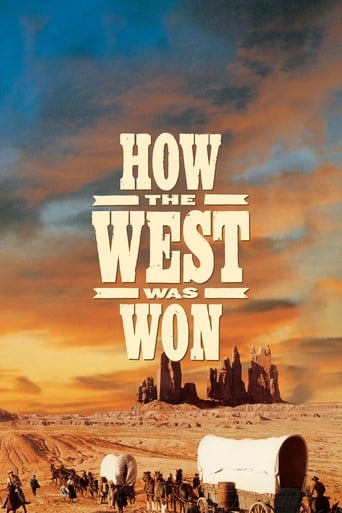



Fantastic!
I wanted to like it more than I actually did... But much of the humor totally escaped me and I walked out only mildly impressed.
View MoreEach character in this movie — down to the smallest one — is an individual rather than a type, prone to spontaneous changes of mood and sometimes amusing outbursts of pettiness or ill humor.
View MoreThe thing I enjoyed most about the film is the fact that it doesn't shy away from being a super-sized-cliche;
View MoreHOW THE WEST WAS WON was the 8th and final Cinerama film. Six travelogues preceded it, as well as MGM's only other feature in the process, THE WONDERFUL WORLD OF THE BROTHERS GRIMM (1962), released the year prior.MGM had taken a chance on the process to be able to satisfy the widescreen and stereophonic craze for epic films, but abandoned it due to its unsatisfactory performance next to its rival, Ultra Panavision 70, in which MGM produced MUTINY ON THE BOUNTY, also in 1962. The use of one camera, one strip of film and no curvature, and the ability to bring back close ups and medium shots sealed Cinerama's fate.This was a grand way to go out though. Five periods of the taming of the West: The River, The Plains, The Civil War, The Railroad, and The Law, and a roster of stars (13 leading, 10 supporting, plus a narrator). It had everything; story, cohesion, thrills – and all in enormous curved screen and Technicolor glory. At two hours and 44 minutes, it was the longest of the 8 Cinerama films and with its final shots (taken from or re-taken as a tribute to the America The Beautiful sequence ending THIS IS CINERAMA (the initial film in the process), it brought the Cinerama story full circle.Sad though that Cinerma cameras had a tendency to be covered with splotches of dirt in its aerial shots. This is rampant throughout the travelogues and here we can see it during Spencer Tracy's initial narration and at the end montage. How digital clean-up for Smilebox DVD presentation could have ignored these obvious defects is beyond my imagination.The image still needs some color correction and the images need sharpening, but the Smilebox DVD release is the best we have so far. The superlative score by Alfred Newman (one of his very best) is in turns stirring and sentimentally moving. Probably the most wrenching scene is Zeb's departure for the war, in which direction, score and the subdued performances of Carroll Baker and George Peppard bring tears.It is recommended to every lover of western films and to those in love with wide screen photography. The locations are gorgeous and always there to look at if one gets bored with the acting, direction or story line. All the actors do a creditable job, with the exception of Debbie Reynold's "old Lilith" at the end of the film. She did go on the next year to earn her only Oscar nom – for THE UNSINKABLE MOLLY BROWN (which used the same mansion exterior as her San Francisco house in WEST, by the way).It is interesting also to note upon reading these almost 150 reviews on the IMDb pages, that there seems to be no middle ground. Either reviewers loved the film or hated it. It's up to you to decide for yourself, but you must not miss it.
View MoreSpectacular. Loved Debbie Reynolds' songs and dances, but there were not enough of them. Not enough John Wayne, Henry Morgan or Henry Fonda. Agnes Moorehead and Carolyn Jones small parts; little dialogue. Didn't like seeing Gregory Peck as a sort-of bad guy. Thelma Ritter hilarious as always. I liked her in her dress-up outfit. Walter Brennan turning out to be a bad guy was a disappointment. Don't get me wrong. It took me forever to see this movie. Was looking forward to it. finally getting to see it. Enjoyed it. More comments: buffalo stampede ingenious. Plucky Debbie Reynolds on a raft; later singing and dancing, reminding one of "Unsinkable Molly Brown". Jimmy Stewart looking like a nasty old goat. Henry Fonda looking a sight better. Debbie teaching the kiddies how to play poker.Primitive man -- not. To them, they were an a-number-one civilization who were encroached by young U.S. and its post-civil always-westward mentality -- complete with army to keep things moving. Pony express first encroaching, then railroads. Today, email is way faster than snail mail or pony express, and people travel by aircraft over vast expanses of the West.
View MoreEpic western filmed in Cinerama. I wish I could have seen it in that format. I saw it on TV and, while it's still a beautiful-looking movie, I can only imagine how much richer the experience would have been to see it in theaters. While not an anthology film exactly, it's similar in that it is a series of different stories tied together by one family over about forty or fifty years of American history. It's all narrated by Spencer Tracy. The first segment deals with a family of settlers heading west. They encounter a mountain man (James Stewart) and one of the daughters (Carroll Baker) falls in love with him. But they all run afoul of a gang of river pirates run by Walter Brennan.The other daughter (Debbie Reynolds), scared away from the West by the hardships her family had to endure, eventually becomes a dance hall girl and is the star of the second segment. Reynolds is left an inheritance by a former customer but in order to collect it, she must head to California. So she joins a wagon train across the plains to the West and is romanced by Robert Preston and Gregory Peck. These first two segments were directed by Henry Hathaway. The first is probably the film's best but the second is the weakest.The third part is directed by John Ford. Stewart and Baker's son, played by George Peppard, follows his father into the war and fights in the Battle of Shiloh. John Wayne plays William Tecumseh Sherman. This is a good segment but seemed short. The fourth segment follows Peppard after the war as he is now part of the U.S. Cavalry. This part deals with the construction of the railroads west, as well as the Pony Express and the telegraph. It features Henry Fonda as a buffalo hunter and Richard Widmark as a railroad tycoon. This segment was directed by George Marshall. It's decent but not the strongest.The final segment is again directed by Hathaway. Debbie Reynolds' character is now a widow and moves to Arizona, where she has invited Peppard and his family to live with her on her ranch. But Peppard, a former lawman at this point, must stop outlaw Eli Wallach from robbing a train. Lee J. Cobb and Carolyn Jones are also in this part. Not a particularly strong segment but a little better than the second one. All in all, a good movie but perhaps it doesn't reach quite what it was aiming for. It definitely has one of the most impressive casts in film history.
View More. . . this often self-contradictory, poorly acted, and downright boring alleged "epic" constitutes a large portion of the pack of lies Grandma and Grandpa were spoon-fed growing up. Only James Stewart and Debbie Reynolds stay on the screen long enough in HOW THE WEST WAS WON to make any impression at all. Top-billed actors such as John Wayne, Karl Mulden, and Lee J. Cobb appear in laughably short cameos. Since 20 minutes of the 164-minute running time is devoted to entrance, intermission, and exit music or credits, only the opening 40-minute "River" part has any meat on its bones. Director John Ford's 20-minute "Civil War" piece is a total joke, and director George Marshall's 22-minute "Railroad" segment is simply a stunt to set up a buffalo stampede. Ditto main director Henry Hathaway's closing "Outlaws" portion, tacked on so "Cinerama" could show a train breaking apart. Hathaway follows his "River" opening part with a somewhat watchable "Plains" story, with a hard-to-like Gregory Peck dueling an even more unlikable Robert Preston for Debbie Reynolds. "Here came the dreamers, with Bible, fist, and gun" blares the chorus as it sings the HOW THE WEST WAS WON title song. "Virus, fist, and gun" would be far more accurate, and most people watching this movie will pull for the Arapaho to prevail with an even stronger virus of their own! Since that does not happen, narrator Spencer Tracy babbles that "the West's names, and the land all HAD to be won from primitive man" in the movie's opening manifesto. How could such a noted actor be so uneducated? If he had even bothered to watch this flick, he would have seen that the Arapaho were the ONLY noble souls in the whole picture! Tracy later states, "This land was known as the West, known to only a handful of White men." I have news for you, bub. The First Peoples knew every nook and cranny and named everything long before "Columbus sailed the ocean blue."
View More